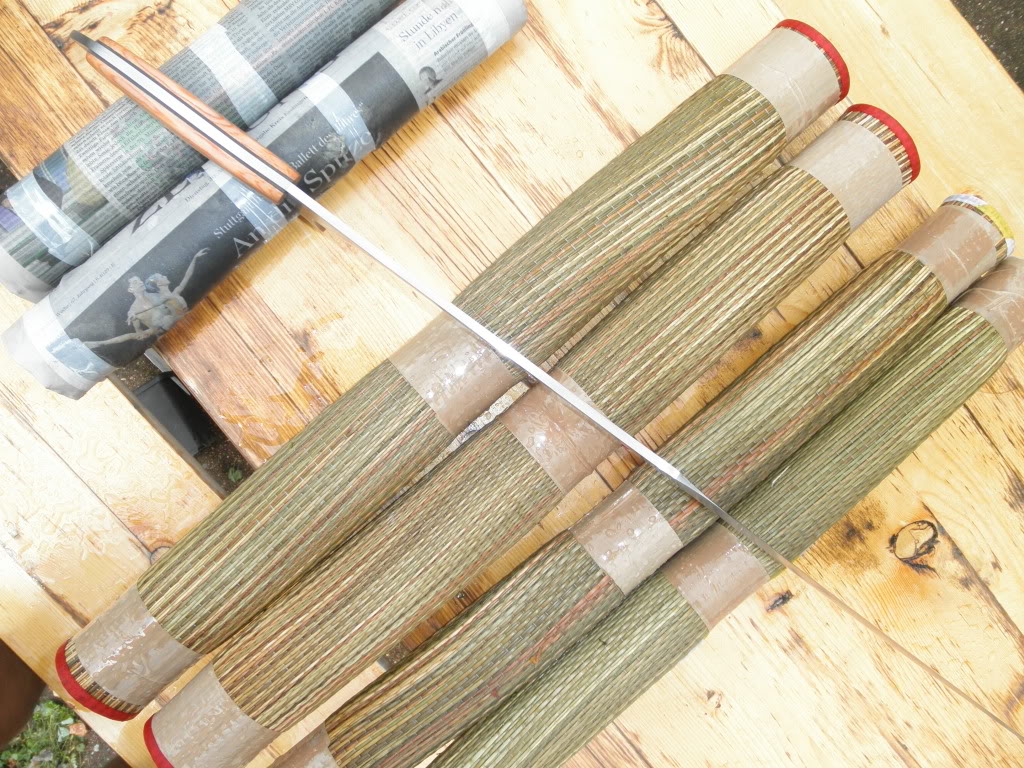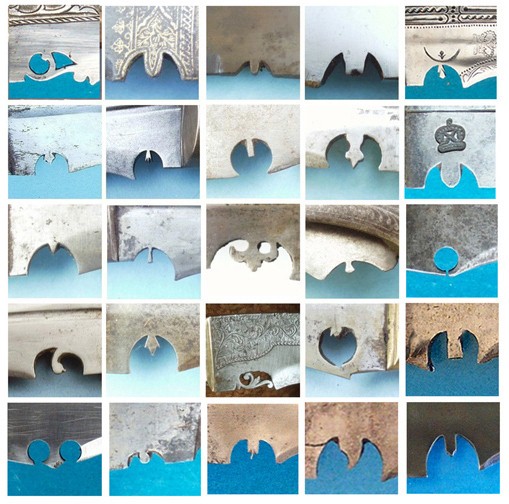| Author |
Message |
|
Lukas MG
Industry Professional
|
 Posted: Sun 04 Sep, 2011 5:37 am Post subject: Modern tactical sword (historians, please don't shy away) Posted: Sun 04 Sep, 2011 5:37 am Post subject: Modern tactical sword (historians, please don't shy away) |
 |
|
Hey guys
I know this is a historically orientated forum but I don't know where else to post this if not here as I cannot post in the the maker's subforum and would still like to share this with you.I hope you don't mind some modern flavour. Mods, please feel free to move this or do with it whatever to deem appropriate.
I suppose one could say that the blade was at least inspired by historical swords, namely kopis, yatagan and filipino weapons.
Anyway, I'm proud to present you "Zorn".
This sword was made during a two week scrap yard project on SBG. The idea was to use only what one had lying around to make the kind of weapon one would want to carry in an apocalyse situation. This is what I came up with:



Stats:
Steel: 56Si7 (for Americans 9260) hardened to 58HRC at the edge, the spine is a bit softer, ca 55HRC, base and tang drawn back to the low 40s.
Overall length: 72cm (28,4”)
Blade length: 55cm (21,6”)
Grip length: 14cm (5,5”)
Blade width at base (where edge starts): 6cm (2,3”)
Blade width 1” before tip: 1cm (0,4”)
CoB: 10,5cm below guard (4,1”)
CoP: will be discussed in the vid, pretty much the upper half of the blade
Blade thickness: 5,5mm (0,210”) at base tapers in a convex curve to 2,5mm (0,100”) before tip.
Weight: 785g (1,7lb)
Handle scales are some unknown wood with leather liners and four steel pins.

When I designed this sword, I wanted to create the best tactical allrounder I could think of. It is not meant to be a deluxe machete but purely a fighting sword that could in some occasions double as a tool. It is however not designed for chopping wood, etc. The sword has a very sturdy blade, backed up by a thick spine that doesn’t taper in thickness until the false edge starts. The upper half features a convex distal taper. So this sword is extremely rigid and has practically no flex. The zero bevel grind gives a very sharp edge with little “niku” but the high hardness and toughness of the steel give more than sufficient durability and edge retention. The curvy design focuses the widest section of the blade right at the CoP where most cutting is done. Needless to say, the curved blade cuts very easily. The point is quite thick and should be sturdy enough for any reasonable thrusting tasks.
The integral guard keeps the hand from slipping onto the blade and the rather sizable pommel would make a nice striking surface aswell. While the grip and pommel design is obviously made for one hand, I can grip the sword with both hands, the second hand wrapping partly around the pommel. The point of the pommel nestles in just between the middle finger and the ring finger.
I went for an old, used but well cared for look on this blade, deliberately leaving some scratches from drawfiling in the spine and antiquing spine and handle with vinegar and salt. It's very hard to see in the pics but very noticeable in person. The blade bevels itself have some minor pitting aswell. That in fact was more of an accident but I like the look well enough and it fits with the theme. If I every grow tired of it I can sand it off.

Handling wise, I’m really happy with how it turned out. It’s very light and fast but still has a pleasant blade presence that does encourage a cutting motion over thrusting. It thrusts well enough but is not primarily balanced for it. The tip stays however in line with the grip and doesn’t wander. Overall, this blade is as easy to control as the light weight suggests but cuts a lot better than its size would make you think.

Enough talking, let’s see what this blade can do!!
Here’s some hard target cutting. I have some light target cutting, too but it’s nothing really spectacular, just a nice sharp blade effortlessly cutting tetra packs and bottles. If you want to see that too, tell me but I feel hard target cutting is what shows this blade’s potential the most.
Here we go:
http://forum.sword-buyers-guide.com/viewtopic.php?f=22&t=6358
As you see, this blade cuts extremely well for such a light sword. Mats were very easy, as was the rest. The hardwood gave me some trouble because I couldn't get it fixed in the stand it was so hard, everything had to be spot on to cut through. But overall I'm very, very happy with how this blade performs!
I’m not entirely sold on the wooden grip; it’s very comfy but grays quite a bit. Hmm, I might add a leather wrap in the middle where my hand touches it the most.
Anyway, that’s it, I hope you like it! It's something else for sure. Comments, etc all welcome!!

|
|
   |
 |
|
William P
|
 Posted: Sun 04 Sep, 2011 6:32 am Post subject: Posted: Sun 04 Sep, 2011 6:32 am Post subject: |
 |
|
whats the purpose of tha notch above the integral guard?
it reminds mequite abit of hadhafang wielded by arwen in LOTR.
i also notice it flares outward on the spine creating a sort of bump, how did that come about is that part of the backedge profile?
|
|
   |
 |
|
Lukas MG
Industry Professional
|
 Posted: Sun 04 Sep, 2011 7:02 am Post subject: Posted: Sun 04 Sep, 2011 7:02 am Post subject: |
 |
|
The notch is there for mainly aesthetic purposes even though it also makes trapping an opponents blade possible I suppose. Otherwise it saves some weight aswell compared to a closed line all the way up to the guard.
The "bump" aesthetically counter balances the other high point where the handle scales begin, therefore marking the second end of the spine's curve and also the begin of the back edge. If you look closely, the blade has no straight line, everything is curved, there are no corners. The guard with it's more angular shape underlines the blade's flowing shape.
|
|
   |
 |
Gene W

Location: The South Of England Joined: 01 Dec 2010
Posts: 116
|
 Posted: Sun 04 Sep, 2011 10:11 am Post subject: Posted: Sun 04 Sep, 2011 10:11 am Post subject: |
 |
|
| Lukas MG wrote: | The notch is there for mainly aesthetic purposes even though it also makes trapping an opponents blade possible I suppose. Otherwise it saves some weight aswell compared to a closed line all the way up to the guard.
The "bump" aesthetically counter balances the other high point where the handle scales begin, therefore marking the second end of the spine's curve and also the begin of the back edge. If you look closely, the blade has no straight line, everything is curved, there are no corners. The guard with it's more angular shape underlines the blade's flowing shape. |
I think that it's an all round excellent job!
Interestingly the 'notch' would serve multiple purposes.
In a deep thrusting stab it would act as a rudimentary 'stop' to help prevent over penetration.
A basic guard.
As you say it might even trap another blade.
But what strikes me is the similarity to the Kaudi (area) on a Kukri blade. The purpose of the Kaudi is that in a stab with the blade 'upright' and the Kaudi facing down, the flow of any blood is broken and directed off of the blade helping to keep the grip from becomming slick.
Best
Gene
|
|
  |
 |
|
Randall Pleasant
Location: Flower Mound, Texas Joined: 24 Aug 2003
Posts: 333
|
 Posted: Tue 06 Sep, 2011 8:08 am Post subject: Re: Modern tactical sword (historians, please don't shy away Posted: Tue 06 Sep, 2011 8:08 am Post subject: Re: Modern tactical sword (historians, please don't shy away |
 |
|
Lukas
Your blade is actually a form of messer (large knife) since it does not have a true pomel like a sword. Being a messer is not a bad thing, I'm just stating what it is. As a practitioner of Medieval and Renaissance Martial Arts I rather have a more tradtional messer. But over all I like your blade.
Ran Pleasant
ARMA DFW
|
|
  |
 |
|
Lukas MG
Industry Professional
|
 Posted: Tue 06 Sep, 2011 8:58 am Post subject: Posted: Tue 06 Sep, 2011 8:58 am Post subject: |
 |
|
Thanks guys.
Yeah I suppose it doesn't qualify as a sword but since these modern bladed weapons are generally called tac swords, I just went with that.
|
|
   |
 |
Glen A Cleeton

|
 Posted: Tue 06 Sep, 2011 9:47 am Post subject: Posted: Tue 06 Sep, 2011 9:47 am Post subject: |
 |
|
Hi Gene
| Quote: | | But what strikes me is the similarity to the Kaudi (area) on a Kukri blade. The purpose of the Kaudi is that in a stab with the blade 'upright' and the Kaudi facing down, the flow of any blood is broken and directed off of the blade helping to keep the grip from becomming slick. |
That reads as myth to me because it assumes blood only runs down the edge. Ha, maybe that is more along the line of fullers as blood runners/gutters 
What I had read from time to time was that the notches on kukri were a some sort of a religious/mythology thing?
Cheers
GC
|
|
  |
 |
|
Jeffrey Faulk
|
 Posted: Tue 06 Sep, 2011 12:14 pm Post subject: Posted: Tue 06 Sep, 2011 12:14 pm Post subject: |
 |
|
| Glen A Cleeton wrote: | Hi Gene
| Quote: | | But what strikes me is the similarity to the Kaudi (area) on a Kukri blade. The purpose of the Kaudi is that in a stab with the blade 'upright' and the Kaudi facing down, the flow of any blood is broken and directed off of the blade helping to keep the grip from becomming slick. |
That reads as myth to me because it assumes blood only runs down the edge. Ha, maybe that is more along the line of fullers as blood runners/gutters 
What I had read from time to time was that the notches on kukri were a some sort of a religious/mythology thing?
|
I believe that this is in fact the original reason the 'cho' notch was made. Explanations vary from being a sort of, ahem, representation of divine... parts, to a metaphorical cow's hoofprint. The best that can honestly be done at this point is plain guesswork based on what various smiths say about it; it's one of those "we've always done it so long that we don't really remember why but we'll darn well do it anyway" kind of things.
http://www.himalayan-imports.com/Construction.html
|
|
  |
 |
Gene W

Location: The South Of England Joined: 01 Dec 2010
Posts: 116
|
 Posted: Thu 08 Sep, 2011 12:15 pm Post subject: Posted: Thu 08 Sep, 2011 12:15 pm Post subject: |
 |
|
| Glen A Cleeton wrote: | Hi Gene
| Quote: | | But what strikes me is the similarity to the Kaudi (area) on a Kukri blade. The purpose of the Kaudi is that in a stab with the blade 'upright' and the Kaudi facing down, the flow of any blood is broken and directed off of the blade helping to keep the grip from becomming slick. |
That reads as myth to me because it assumes blood only runs down the edge. Ha, maybe that is more along the line of fullers as blood runners/gutters 
What I had read from time to time was that the notches on kukri were a some sort of a religious/mythology thing?
Cheers
GC |
Hi Glen,
Certainly not a myth.
Each form of Kaudi doubtless has a special meaning. It is said that many are based on various styles of temple roof.
Occasionally you will even see one where it's design is so elaborate that it purpose is surely compromised.
However, the practical reason for the Kaudi IS to help direct blood/water/sap flow away from the hilt and it's stylistic development of varied significance is separate.
A favoured attack is an upward stab to the guts causing the victim to double-over. The attacker would then wrench the Kukri free and behead the target with a single downward slash to the back of the doubled-over persons neck.
Various aspects of the Kukri form would (despite the lack of guard) help to direct the flow of liquid away from the hand.
Here are some examples of Kaudi:
 Attachment: 109.59 KB Attachment: 109.59 KB

|
|
  |
 |
Gene W

Location: The South Of England Joined: 01 Dec 2010
Posts: 116
|
 Posted: Thu 08 Sep, 2011 12:36 pm Post subject: Posted: Thu 08 Sep, 2011 12:36 pm Post subject: |
 |
|
[quote="Jeffrey Faulk"] | Glen A Cleeton wrote: | Hi Gene
I believe that this is in fact the original reason the 'cho' notch was made. Explanations vary from being a sort of, ahem, representation of divine... parts, to a metaphorical cow's hoofprint. |
I imagine that both those and other designs are represented, along with many others.
It might be easier to visualise the practical purpose with some pics of the whole items.
Interestingly I only have one without a Kaudi, and it would have been made for a western military owner: air crew or tank crew.
 Attachment: 168.33 KB Attachment: 168.33 KB
[ Download ]
|
|
  |
 |
Jean Thibodeau

|
 Posted: Thu 08 Sep, 2011 8:40 pm Post subject: Re: Modern tactical sword (historians, please don't shy away Posted: Thu 08 Sep, 2011 8:40 pm Post subject: Re: Modern tactical sword (historians, please don't shy away |
 |
|
| Lukas MG wrote: | Hey guys
I know this is a historically orientated forum but I don't know where else to post this if not here as I cannot post in the the maker's subforum and would still like to share this with you.I hope you don't mind some modern flavour. Mods, please feel free to move this or do with it whatever to deem appropriate.
I suppose one could say that the blade was at least inspired by historical swords, namely kopis, yatagan and filipino weapons.
|
Well a good design is always interesting to see, historical or not, at least for me.   
And yes it does share design features with the historical types you mention, but it is an original interpretation of a very functional shape.
Even in modern piece maybe not 100% original since all the " useful " blade shapes have been invented or re-invented at different times in history and different parts of the World.
In short I like it.  
You can easily give up your freedom. You have to fight hard to get it back!
|
|
  |
 |
Glen A Cleeton

|
 Posted: Thu 08 Sep, 2011 9:33 pm Post subject: Posted: Thu 08 Sep, 2011 9:33 pm Post subject: |
 |
|
Hi Gene
| Quote: | | However, the practical reason for the Kaudi IS to help direct blood/water/sap flow away from the hilt and it's stylistic development of varied significance is separate |
I appreciate the response and certainly the time to share so many examples but it does not sway my own opinion that it presumes blood only runs down the edge (when blood flows and flies any direction force takes it. I can offer another reason blades are ground such and have appeared in many cultures but then I digress way off topic for this thread. Simply to aid sharpening comes to mind 
Cheers
GC
|
|
  |
 |
|
Lukas MG
Industry Professional
|
 Posted: Fri 09 Sep, 2011 8:05 am Post subject: Posted: Fri 09 Sep, 2011 8:05 am Post subject: |
 |
|
Thanks for all the kind comments.
Never though my sword would provoke such an interesting discussion about kukris 
|
|
   |
 |
Gene W

Location: The South Of England Joined: 01 Dec 2010
Posts: 116
|
 Posted: Fri 09 Sep, 2011 12:25 pm Post subject: Posted: Fri 09 Sep, 2011 12:25 pm Post subject: |
 |
|
| Glen A Cleeton wrote: | Hi Gene
| Quote: | | However, the practical reason for the Kaudi IS to help direct blood/water/sap flow away from the hilt and it's stylistic development of varied significance is separate |
I appreciate the response and certainly the time to share so many examples but it does not sway my own opinion that it presumes blood only runs down the edge (when blood flows and flies any direction force takes it. I can offer another reason blades are ground such and have appeared in many cultures but then I digress way off topic for this thread. Simply to aid sharpening comes to mind 
Cheers
GC |
Hi Glen,
Grab one of your Kuk's and 'heft it' a bit. You can see the logic of the Kaudi and the 'flow' LOL, I did toy with the idea of a video clip of water pouring onto a kukri....
But I don't want to get any of mine soaking wet!
But! Here are some references:
http://www.ayo-gorkhali.org/index.php/gurkhas/the-kukri/
"The small notch on the blade just above the kukri's handle is called the cho, kaudi or kauda and acts as a drip channel - diverting plant sap or blood away from the handle so that the hand of the wielder doesn't become excessively slippery."
http://nepalkhukurihouse.com/parts-of-kukri.php
"Cho/Notch (Kaudi): A distinctive cut (numeric 3 like shape) in the edge functioned as a blood dropper and others. "
And an interesting discussion on the subject on www.ikrhs.com:
http://www.ikrhs.com/forums/viewtopic.php?f=1...ilit=kaudi
When I was a kid people used to regualrly claim that the Kaudi was there to 'knick' ones finger when the Kukri was drawn as it had to draw blood every time it was pulled out.
BS of course!
As I say, you're right about that every design has a deeper symbolic significance though.
Best
Gene
|
|
  |
 |
Gene W

Location: The South Of England Joined: 01 Dec 2010
Posts: 116
|
 Posted: Fri 09 Sep, 2011 12:38 pm Post subject: Posted: Fri 09 Sep, 2011 12:38 pm Post subject: |
 |
|
| Lukas MG wrote: | Thanks for all the kind comments.
Never though my sword would provoke such an interesting discussion about kukris  |
Yeah, sorry Lukas.
|
|
  |
 |
|
Geoff Wood
|
 Posted: Fri 09 Sep, 2011 1:46 pm Post subject: Posted: Fri 09 Sep, 2011 1:46 pm Post subject: |
 |
|
| Gene W wrote: | | Glen A Cleeton wrote: | Hi Gene
| Quote: | | However, the practical reason for the Kaudi IS to help direct blood/water/sap flow away from the hilt and it's stylistic development of varied significance is separate |
I appreciate the response and certainly the time to share so many examples but it does not sway my own opinion that it presumes blood only runs down the edge (when blood flows and flies any direction force takes it. I can offer another reason blades are ground such and have appeared in many cultures but then I digress way off topic for this thread. Simply to aid sharpening comes to mind 
Cheers
GC |
Hi Glen,
Grab one of your Kuk's and 'heft it' a bit. You can see the logic of the Kaudi and the 'flow' LOL, I did toy with the idea of a video clip of water pouring onto a kukri....
But I don't want to get any of mine soaking wet!
But! Here are some references:
http://www.ayo-gorkhali.org/index.php/gurkhas/the-kukri/
"The small notch on the blade just above the kukri's handle is called the cho, kaudi or kauda and acts as a drip channel - diverting plant sap or blood away from the handle so that the hand of the wielder doesn't become excessively slippery."
http://nepalkhukurihouse.com/parts-of-kukri.php
"Cho/Notch (Kaudi): A distinctive cut (numeric 3 like shape) in the edge functioned as a blood dropper and others. "
And an interesting discussion on the subject on www.ikrhs.com:
http://www.ikrhs.com/forums/viewtopic.php?f=1...ilit=kaudi
When I was a kid people used to regualrly claim that the Kaudi was there to 'knick' ones finger when the Kukri was drawn as it had to draw blood every time it was pulled out.
BS of course!
As I say, you're right about that every design has a deeper symbolic significance though.
Best
Gene |
How does this fit with the Chitlange/Chainpure types where the bit in question is a hole in the blade?
Regards
Geoff
|
|
  |
 |
Gene W

Location: The South Of England Joined: 01 Dec 2010
Posts: 116
|
 Posted: Fri 09 Sep, 2011 2:20 pm Post subject: Posted: Fri 09 Sep, 2011 2:20 pm Post subject: |
 |
|
| Quote: | How does this fit with the Chitlange/Chainpure types where the bit in question is a hole in the blade?
Regards
Geoff |
As I say, some types clearly compromise the purpose.
Often though, there is some effort to direct the flow, even when the Kaudi is a 'closed' type.
Best
Gene
|
|
  |
 |
|
|
You cannot post new topics in this forum
You cannot reply to topics in this forum
You cannot edit your posts in this forum
You cannot delete your posts in this forum
You cannot vote in polls in this forum
You cannot attach files in this forum
You can download files in this forum
|
All contents © Copyright 2003-2025 myArmoury.com — All rights reserved
Discussion forums powered by phpBB © The phpBB Group
Switch to the Basic Low-bandwidth Version of the forum
|

